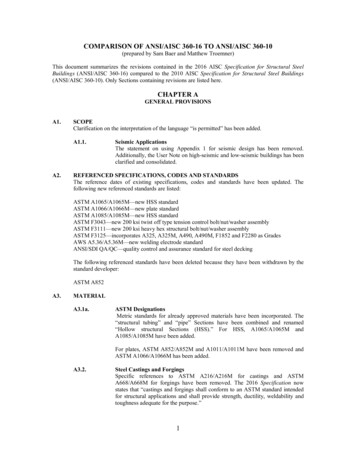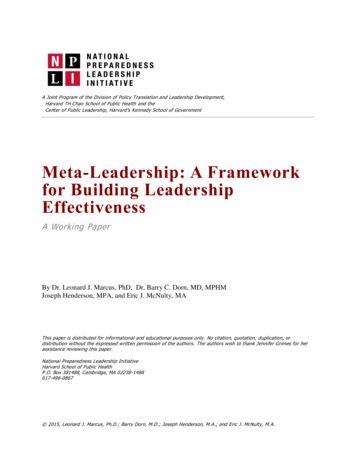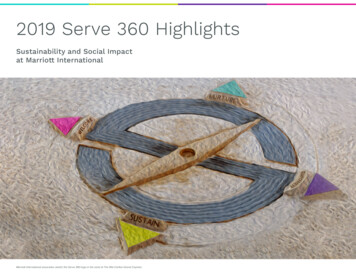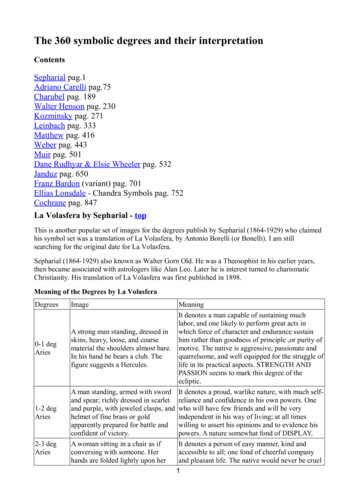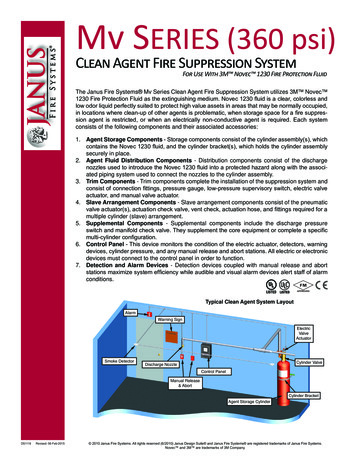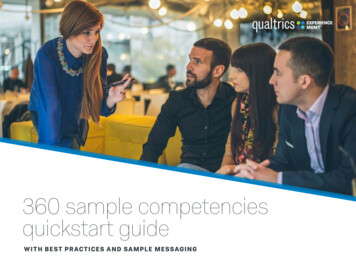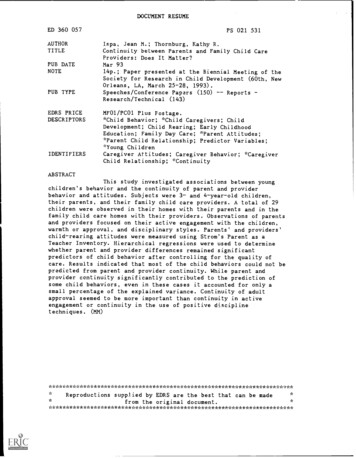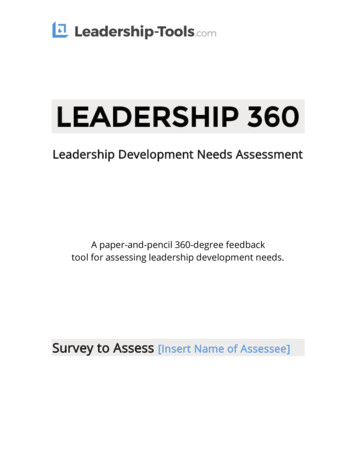
Transcription
LEADERSHIP 360Leadership Development Needs AssessmentA paper-and-pencil 360-degree feedbacktool for assessing leadership development needs.Survey to Assess [Insert Name of Assessee]
IntroductionThank you for agreeing to help assess the leadership behavior of [INSERT ASSESSEENAME]. By doing so, you will provide this fellow organizational member with valuablefeedback on his/her leadership development needs. The primary goal of this program is toimprove our organization’s leadership. We appreciate your assistance in performing thisvital task.We are distributing copies of this tool to this person’s superiors, subordinates, and peers forcompletion. By surveying up, down, and across (360 degrees), we can provide participantswith information unobtainable from conventional assessment instruments. Unlike someother 360-degree instruments, this activity is anonymous – we will not ask you for anypersonal information, including whether you are a superior, subordinate, or peer. Theauthors of this tool believe that anonymity facilitates honest, objective, and user-friendlyfeedback. As you will note, we do not include space for written comments. The authorshave observed that a single written comment often serves as a major distraction from theneeds-analysis process.Instructions1. For each behavioral scale, please circle the bullet that best reflects the behavior of[INSERT ASSESSEE NAME].EXAMPLE:Thinks long-term Thinks short-termIn this instance, the assessor thought that the person being assessed spends somewhatmore time thinking short-term than long term. If the evaluator had thought the individualbeing assessed spent about the same amount of time thinking short and long term, theevaluator would have circled the middle bullet. A key to successful completion of this tool isto read each behavioral scale closely and then go with your first impression. If youencounter a scale covering behavior that you have not had the opportunity to observe,simply skip that scale.2. In a sealed envelope, return the completed LEADERSHIP 360 survey form to:[INSERT NAME /ADDRESS OF INDIVIDUAL COMPILING DATA ]Thank you for your participation!
LEADERSHIP 360 SurveyStrategyThinks long-term Thinks short-termLacks a vision forher/his organization Has a vision for her/hisorganizationSpends time settingthe direction forher/his organization Spends time fightingfires and resolvingcrisesCommunicationIs a goodcommunicator Is a poorcommunicatorIs cloistered Is active in theorganizationCommunicates wellwith otherorganizations Communicates poorlywith otherorganizationsTends to be noncommunicative Communicatesfrequently
KnowledgeHas a deep-rootedunderstanding of thefunctions of her/hisorganization Does not try tounderstand thefunctions of her/hisorganizationDoes not understandfunctions of otherorganizations Understands functionsof other organizationsIs close to thebusiness Is not close to thebusinessTakes the narrow view Takes the broad viewLearningIs curious Isn’t interested/doesn’thave timeResists change Promotes changeIs a quick study Is a slow, deliberatestudy
InfluenceGets support Fails to get supportDoesn’t know how tosell Knows how to sellGets people on board Fails to get people onboardMotivates people Fails to motivatepeopleIs dictatorial Is democraticIs unassertive Is assertiveRelationshipsDoes not talk topeople Talks to peopleIs a good listener Is a poor listenerIs good interpersonally Is poor interpersonally
Relationships continuedIs unable to deal withpeople Is able to deal withpeopleDoes not interact withpeople enough Interacts with peopleDelegationIs a good delegator Is a poor delegatorIs detail-oriented Is big picture-orientedIs a nitpicker Is not a nitpickerDeals with theimportant issues Deals withinconsequential detailIs a doer Is a delegator Is unable to prioritizePrioritiesIs able to prioritize
IntegrityHas integrity Lacks integrityIsn’t trusted Is trustedIs overly political Is political only asneededTakes responsibility forself Blames othersAdmits mistakes Doesn’t admitmistakesIs honest, credible Is dishonest, lackscredibilityConfidenceIs insecure Is secureHas guts Has no gutsIs unwilling to makeenemies Is willing to makeenemies
Confidence continuedIs decisive Is indecisiveCommunicatesconfidence Communicates fearsIs unwilling to makethe tough decisions Is willing to make thetough decisionsPlease return the survey to [insert administrator’s name and address] by[insert date].
LEADERSHIP 360Leadership Development Needs AssessmentA paper-and-pencil 360-degree tool forassessing leadership development needs.Administrator’s GuideIntroductionThank you for agreeing to serve as the organizational administrator for the LEADERSHIP 360program. By doing so, you will provide members of the organization with valuable feedbackon individual leadership development needs. The primary goal of this program is to improveour organization’s leadership. We appreciate your assistance in performing this vital task.You will be distributing copies of this tool to a participant’s superiors, subordinates, andpeers for completion. By surveying up, down, and across (360 degrees), we can provideparticipants with information unobtainable from conventional assessment instruments.Unlike some other 360-degree instruments, this activity is anonymous – those surveyed willnot be asked for any personal information, including whether or not they are a superior,subordinate, or peer. The authors of this tool believe that anonymity facilitates honest,objective, and user-friendly feedback. As an administrator, you play a key role in ensuringthe confidentiality of results. Please treat completed forms and feedback sheets with thesame confidentiality as you would with your personal records.
Instructions1. Select organizational members to be evaluated.LEADERSHIP 360 is designed for organizational leaders and candidates for leadershippositions. The behaviors evaluated are broad and generic, allowing both formal andinformal leaders to participate. LEADERSHIP 360 is designed for leadershipdevelopment purposes only. The authors do not endorse its use for performanceappraisal or for selection purposes. Ensure that individuals to be evaluated concur withparticipation in this process before proceeding.2. Select evaluators.Meet with the participant to select evaluators. The participant’s direct supervisor, alldirect subordinates and peers should participate. If possible, concur with the participanton a list of 10 or more potential evaluators. Then, contact the potential evaluators toconfirm their willingness to participate in the analysis.3. Distribute survey to evaluators.Use a confidential means to distribute the survey booklets - sealed mail and in-persondelivery have both been used successfully by other organizations. No matter whatdistribution method you use, be sure that you provide the evaluators with an easy,confidential method for returning completed surveys to you (such as a self-addressed,stamped envelope).4. Compile statistics.Once you have received the completed forms, compile statistics using the attachedscoring key (Appendix A). For the first behavior scale (Thinks long-term/Thinks shortterm) add up the numbers corresponding with the ratings assigned by the evaluatorsand then divide by the number of responses for that behavior to obtain an averagescore for that behavior. Record the score on the calculation worksheet (Appendix B).Repeat this process for each behavior scale on the survey. Then, calculate the averagescore for each leadership area (such as Strategy) by adding the average scores of thebehaviors, and dividing by the number of behaviors. To calculate the overall score forLEADERSHIP 360, add the average scores for the leadership areas and divide by 10 (thenumber of leadership areas).
5. Complete a feedback summary sheet for each participant.Transfer the leadership area scores and overall score to the feedback sheet (AppendixC). If you are conducting several LEADERSHIP 360’s, you may want to determine averagescores for your population and record them on the feedback summary sheets forcomparison.6. Hold a feedback session with each participant.Hold one-on-one feedback sessions with each LEADERSHIP 360 participant: Provide the participant with a quick overview of the LEADERSHIP 360 process:purpose (development); survey process; confidentiality of results, and bases forareas, behaviors, and methodology:Kaplan, R. E. (1988) The warp and the woof of the general manager’s job. InF. Schoorman, and B. Schneider (eds.), Facilitating work effectiveness.Lexington, MA: Lexington Books. (a seminal piece on effective executivebehavior - the source of executive leadership areas and most behaviors inLEADERSHIP 360 )Keeley, W. A. (1997) Management training and development needs analysis.Carlsbad, NM : U.S. Department of Energy Carlsbad Area Office. (theLEADERSHIP 360 needs analysis approach evolved from this assessmenttool)Keeley, W. A. (1997 - unpublished) Field test notes for LEADERSHIP 360.Carlsbad, NM . (the norming data in Appendix C. came from these notes) Review the leadership areas, behaviors, and scoring, using Appendix A. Be surethe participant understands the scoring process. Note: retain Appendix A afterreview Review completed Appendices B and C with the participant. Allow theparticipant plenty of time to consider the results and ask questions. Then askthe participant how she or he can use the information to improve her/hisleadership. Note: Give the participant Appendices B and C to keep. Ask the participant and evaluators for feedback on LEADERSHIP 360 Place a reminder of the calendar to re-take the LEADERSHIP 360 a year in thefuture for the purpose of measuring improvement.
Appendix ALEADERSHIP 360 Scoring KeyStrategyThinks long-term54321Thinks short-termLacks a vision forher/his organization12345Has a vision for her/hisorganizationSpends time settingthe direction forher/his organization54321Spends time fightingfires and resolvingcrisesCommunicationIs a goodcommunicator54321Is a poorcommunicatorIs cloistered12345Is out and about in theorganizationCommunicates wellwith otherorganizations54321Communicates poorlywith otherorganizationsTends to be noncommunicative12345Communicatesfrequently
KnowledgeHas a deep-rootedunderstanding of thefunctions of her/hisorganization54321Does not try tounderstand thefunctions of her/hisorganizationDoes not understandfunctions of otherorganizations12345Understands functionsof other organizationsIs close to thebusiness54321Is not close to thebusinessTakes the narrow view12345Takes the broad viewLearningIs curious54321Isn’t interested/doesn’thave timeResists change12345Promotes changeIs a quick study54321Is a slow, deliberatestudy
InfluenceGets support54321Fails to get supportDoesn’t know how tosell12345Knows how to sellGets people on board54321Fails to get people onboardMotivates people54321Fails to motivatepeopleIs dictatorial12345Is democraticIs unassertive12345Is assertiveRelationshipsDoes not talk topeople12345Talks to peopleIs a good listener54321Is a poor listenerIs good interpersonally54321Is poor interpersonally
Relationships continuedIs unable to deal withpeople12345Is able to deal withpeopleDoes not interact withpeople enough12345Interacts with peopleDelegationIs a good delegator54321Is a poor delegatorIs detail-oriented12345Is big picture-orientedIs a nitpicker12345Is not a nitpickerDeals with theimportant issues54321Deals withinconsequential detailIs a doer12345Is a delegator1Is unable to prioritizePrioritiesIs able to prioritize5432
IntegrityHas integrity54321Lacks integrityIsn’t trusted12345Is trustedIs overly political12345Is political only asneededTakes responsibility forself54321Blames othersAdmits mistakes54321Doesn’t admitmistakesIs honest, credible54321Is dishonest, lackscredibilityConfidenceIs insecure12345Is secureHas guts54321Has no gutsIs unwilling to makeenemies12345Is willing to makeenemies
Confidence continuedIs decisive54321Is indecisiveCommunicatesconfidence54321Communicates fearsIs unwilling to makethe tough decisions12345Is willing to make thetough decisions
Appendix BLEADERSHIP 360 Calculation WorksheetArea/Behavior(Positive behaviors are in bold)AverageScoreBehaviorStrategyThinks long-termThinks short-termHas a vision for her/hisorganizationLacks a vision for her/his organizationSpends time setting the direction forher/his. . .Add average scores for the 3 Strategybehaviors:Spends time fighting fires . . .Divide by 3 Strategy ScoreIs a poor communicatorIs out and about in theorganizationCommunicates well with otherorganizationsCommunicates poorly with otherorganizationsTends to be non-communicativeCommunicates frequentlyAdd average scores for the 4Communications behaviors:Divide by 4 Communications ScoreCommunicationIs a good communicatorIs cloisteredKnowledgeHas a deep-rooted understanding ofthe functions of her/his organizationDoes not try to understand thefunctions of her/his organizationDoes not understand functions ofother organizationsUnderstands functions of otherorganizationsIs close to the businessIs not close to the businessTakes the narrow viewTakes the broad viewAdd average scores for the 4Knowledge behaviors:Divide by 4 Knowledge Score
LearningIs curiousIsn’t interested/doesn’t have timeResists changePromotes changeIs a quick studyIs a slow, deliberate studyAdd average scores for the 3 Learningbehaviors:Divide by 3 Learning ScoreGets supportFails to get supportDoesn’t know how to sellKnows how to sellGets people on boardFails to get people on boardMotivates peopleFails to motivate peopleIs dictatorialIs democraticIs unassertiveIs assertiveDivide by 6 Influence ScoreDoes not talk to peopleTalks to peopleIs a good listenerIs a poor listenerIs good interperson
participant plenty of time to consider the results and ask questions. Then ask the participant how she or he can use the information to improve her/his leadership. Note: Give the participant Appendices B and C to keep. Ask the participant and evaluators for feedback on LEADERSHIP 360 Place a reminder of the calendar to re-take the LEADERSHIP 360 a year in the future for the purpose of .
